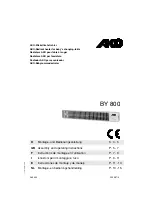
Page 7 of 20
TECHNICAL DATA
Refer to the appliance data
ENSURE THAT THE LOCAL CONDITIONS OF USE CORRESPOND TO THE DATA ON THE BADGE
Natural Gas G20
Propane G31
Category
I2H
I3P
Supply Pressure
20mBar
37mBar
Inlet Pressure
20mBar
*
37mBar
*
Heat Input (net)
(High)
2.5kW
2.5kW (180g/h)
(Low)
1.5kW
1.5kW (107g/h)
Inlet Connection
8mm Compression
8mm Compression
Injector
Elbow 92/180
Elbow 92/90
*
The inlet pressure must be
/- 1mBar
of specification with
all
gas appliances in the house
switched on
and also
with just the Burley appliance operating. If outside of this tolerance the
fault is most likely to be in the installation pipe work or service governor at the meter. If the
problem is the meter governor, this is the property of the gas service provider (such as Transco /
National Grid 0800 111999 or Bord Gais) and they should be called to rectify this. The fire will not
operate correctly if the pressures are incorrect. It may be hard to light or the pilot may cut out
when the burner turns off under thermostatic control.
Disposal
UNPACKING THE APPLIANCE
2.1
Carefully examine the carton for damage before unpacking. If it is obviously damaged,
consult the supplier as to whether to proceed with the installation.
2.2
Make sure the carton is stood upright and open the top. Remove the cardboard top fitting
and place to one side; this box can be used as a hearth protector when installing the fire.
2.3
Remove the fittings boxes contained within and open them and check the condition of the
contents. Remove the fire and examine its general condition, paying particular attention
to the frame, the glass front and fire box flanges.
2.4
If satisfied by the general condition, place the decorative components to one side and
proceed with the installation. If in any doubt, seek advice from the supplier.
Read these
instructions fully before proceeding even if you have fitted this model before.
Recycling Information
:
The metallic & glass parts of the appliance & its packaging should be
sorted for environmental-friendly recycling.
WEEE
: Dispose of electrical equipment in an environmentally correct
manner.
When disposing components containing Refractory Ceramic Fibres (RCF),
we recommend that the items are not broken up, but are sealed within
heavy duty polythene bags, and clearly labelled as RCF waste. RCF waste
may be disposed of in suitably licensed landfill sites.






































